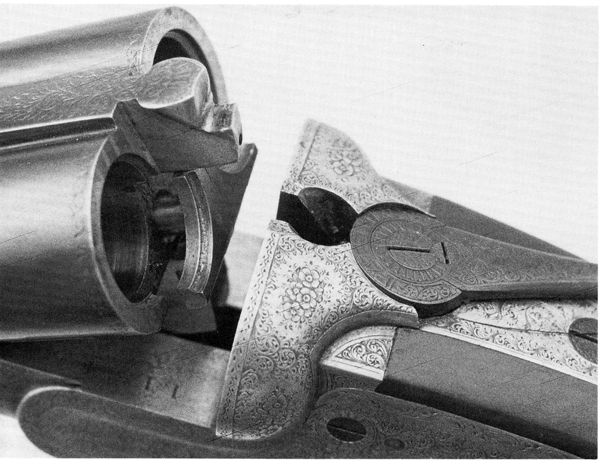|
|
|
|
|
Design - The Webley Screw Grip
Following early development of breech loading shotgun, many users and makers alike, showed concerned over the strength of the barrel/action mechanism. Prior to the breech loader, muzzle loading was the only option. In spite of its limitations concerning slow loading, potential safety issues with accidental discharge during rapid reloading, etc, time had proven this to be a solid construction method. The breech loader, in turn, offered many advantages over the muzzle loader but the strength of the breech mechanism raised concerns. Nowadays, testing such a design using computer aided design systems and modern engineering simulation techniques would show designers/engineers what occurs during the explosive discharge but of course this technology would have to wait another century to appear. Victorian gunmakers therefore had to rely on the solid engineering techniques of the day and hence why many differing solutions for breech mechanism would undergo trial and developed. Gunmakers developed or indeed adopted alternative designs such as the rotary under lever, sliding breech, swivel breech and so on. Stephen Grant (one of my favourite English gunmakers) often utilized the side lever principle but what became the principally adopted design would be the Purdey sliding bolt in combination with the Scott style spindle and top lever. For wild fowlers, the muzzle loader offered a degree of strength that allowed the shooter to increase his powder and shot load (within bounds) to increase range or pattern coverage. For the breech loader similar opportunities for increased loads also became available through proliferation of alternative cartridges, but the increased explosive pressure in the breech raised concerns about bursting. A further concern of the breech loader was the flexing of the action, particularly when discharging heavier cartridge loads. A common belief at the time was that flexing occurred between the action face and the barrel breech, potentially allowing discharge of gases through the normal tight fitting face of the barrel/action. This flexing effect in the longer term potentially could lead to fatigue and eventual catastrophic failure of the action (normally a crack between the action face and flat). Again, in today's world, modern computer simulation would allow an understanding of the stress endured by the action during the process of cartridge discharge, but in the 1870's makers could only rely on a combination of good physical design and trial & error! Because of the heavier cartridge loads generally used in live pigeon shooting competitions and wild fowling, some makers decided to employ an additional feature referred to as 'clipped fences' which attempted to reduce potential sideways barrel movement. Here small extensions or ears protruded from the edges of the action fences which engaged with chamfers cut off the leading edges of the barrel face. In reality it is unlikely this design, to any great extent, effected sideways flexing of the barrel breech. With these concerns in mind, to increase the strength of the breech mechanism, some makers developed what is often referred to as a 'third bite'. This was in addition to the Purdey sliding bolt mechanism and was affected through an extension off the front face of the barrel, effectively a rearward extension of the top rib. Again, gunmakers created different designs to overcome the safety concerns of their Victorian customers. For example, the Birmingham based maker, Greener developed the cross bolt mechanism, which in combination with the Scott style top lever passed a sliding bolt though a hole in this top extension. Similarly, Scott (later Webley & Scott) developed a similar third bite to Greener but with a square sectioned cross bolt. This third bite in combination with the Purdy sliding bolt gave the breech loader considerable additional strength, the design concept finding its way into the construction of many express rifles and of course the live pigeon gun of the latter 1800's, the users of which often preferred heavier 3" cartridge loads.
Next Page
|
